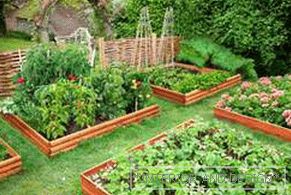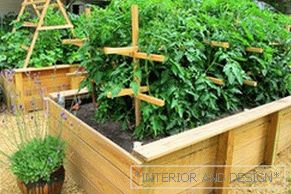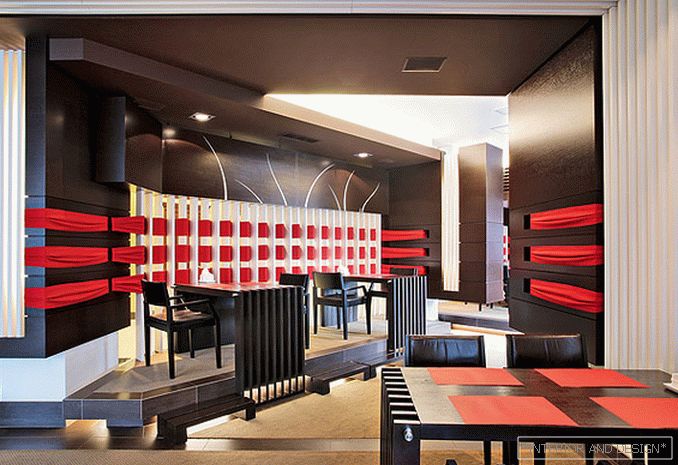 Russians love to work on the ground. Most of our fellow citizens have country or household plots on which they grow a variety of garden crops.
Russians love to work on the ground. Most of our fellow citizens have country or household plots on which they grow a variety of garden crops.
Any gardener seeks to get a rich harvest from their land, but this is not always possible due to the lack of available space. Standard six acres are often not enough for planting all garden crops. However, the solution to this problem has long been found - high beds. Today we will talk about how to create vertical gardening, its advantages and disadvantages.
Content
- 1 Ways to create vertical beds
- 2 Rules for creating high beds
- 3 High Bed Assembly Stages
- 4 Pros and cons of using high beds
- 5 How to eliminate some cons?
Ways to create vertical beds
 There are a lot of standard designs. The most popular are whatnot and pyramids. The fact is that to create them you can use any available materials: old boards, car tires, metal cuts - all that is at hand.
There are a lot of standard designs. The most popular are whatnot and pyramids. The fact is that to create them you can use any available materials: old boards, car tires, metal cuts - all that is at hand.
Pyramidal structures can be single and double sided. Very often, such structures are constructed for the cultivation of strawberries, strawberries and greens.
High step beds can be made from a leaky barrel, which can not be returned tight. To do this, holes are drilled in its walls, and bags of black polyethylene with primer are placed inside. The central part of this design is better to take under the irrigation system.
By the way, plastic bags themselves can become the main high beds. With their help, you can make pockets of soil on the fence, which then planted garden crops. Five to six such pockets are enough to provide a small family with salads and greens. In addition, such solutions are able to perform the role of summer landscapes.
Some gardeners manage to use ordinary plastic bottles to create high beds. They are suspended on the same fence.
Amazing high beds are made from packaging materials. It is enough to cover the same pallets with a protective composition and sheathe the inside with a nonwoven covering material to obtain a vertical bed. Such a design can be used not only in the garden, but also in urban loggias.
Rules for creating high beds
 For a high bed to be productive, you need to correctly calculate its height, length and width.
For a high bed to be productive, you need to correctly calculate its height, length and width.
If your structure will stand on loose ground, then its height may be limited to fifteen centimeters. When the bed will be on weight, lack to the ground, then its height should be doubled. Structures with compost should be fifty centimeters high.
Want to make high beds at the height of your belt for easy plant care and harvesting? The idea is good, but with its implementation, you need to properly design their width. It should be such that you can easily reach the middle of the structure. Its maximum width is one hundred centimeters. This is enough for planting horticultural crops in two rows, which is an undoubted advantage.
As for the length of the high beds, here no restrictions. This parameter is limited only by the size of the area. And yet, it is not recommended to make them unnecessarily long, since such structures are not very stable.
High Bed Assembly Stages
- Selection of a suitable site for a high bed and its clearing. The place should be sunny and closed from the wind.
- Marking territory. At this stage it is necessary to calculate the height and width of the structure.
- The construction of the main body of a pre-selected material. To protect seedlings and crops from rodents on the bottom of a high bed, standing on the ground, should be laid a fine metal mesh.
- Formation basis. Layers of straw, sawdust, grass and twigs are laid into it.
- Laying the middle layer of organics. If the high bed is warm, then use compost. It will not only warm the beds, but also provide nutrients to the soil. At the same time, before laying the fertile layer, it is necessary to sustain a layer of organic matter - let it settle, and then add a little more compost.
- Laying the main soil layer. Its thickness should not be less than ten centimeters.
- Watering the beds without mixing layers.
Pros and cons of using high beds
It's time to talk about the advantages and disadvantages of vertical structures. Let's start with the pros:
-
 A high bed warms up superbly in springtime and allows early sowing of plants, which leads to a doubling of the crop.
A high bed warms up superbly in springtime and allows early sowing of plants, which leads to a doubling of the crop. - High walls ensure the preservation of mulch. It does not wash out with precipitation and does not blow it away.
- Properly designed high construction provides good drainage and eliminates stagnant processes in the soil.
- Possibility of individual selection of soil for different beds. This means that the probability of the spread of diseases between them is excluded. In addition, due to the high walls, optimal conditions are created for individual garden crops.
- A high bed smooths out sharp drops in air temperature, which also leads to higher yields.
- More efficient use of the available area of the garden plot.
- No need to dig and weed the soil.
- Comfortable care for plants. A person does not need to lean in three deaths for the care of plants and harvest. This is especially important for older people.
- Nice appearance. In some cases, the beds can act as decorative elements in landscape design.
- Such a design can be installed in any corner of the garden, only there was enough sun. Moreover, the bed can be placed where previously nothing could be grown before due to the nature of the soil.
- Easy care of the aisles. They can be banal covered with rubble and forget about weeds.
By cons high beds include the following points:
- Quick drying of the soil. For this reason, when creating such structures, it is necessary to use various methods of combating drying. We will tell about them a bit later.
- Limited soil volumes. In order for garden crops to feel comfortable in high beds one must constantly add various types of fertilizer to the soil. In this case, the dosage of plants is quite difficult to calculate.
- Increased risk of development of microflora dangerous for plants.
- Increased financial spending when creating high structures in comparison with the usual. Unfortunately, no materials are available for free today.
- Excessive warming up of the soil can lead to early ripening of cold-resistant crops. These include popular in Russia spinach and garlic.
- In winter, the soil in the high beds freezes through. For this reason, perennial plants do not survive in it.
How to eliminate some cons?
Quick drying of the soil You can compensate in several ways:
-
 Use hydrogel. This polymer must be added to the soil when creating a high bed. It will accumulate moisture during irrigation and will become a source of water for plants. Planted crops will be able to pick up liquid from swollen granules as needed. Hydrogel does not provide complete protection against drying.
Use hydrogel. This polymer must be added to the soil when creating a high bed. It will accumulate moisture during irrigation and will become a source of water for plants. Planted crops will be able to pick up liquid from swollen granules as needed. Hydrogel does not provide complete protection against drying. - The use of drip irrigation system. Yes, the solution is expensive, but very effective. In addition, you can significantly reduce costs if you collect the drip system yourself from scrap materials.
Compensate for quick depletion soil can be a selection of plants. For example, you can plant greens and vegetables with a small root system. But you still have to feed the plants. True, fertilizer consumption will decrease significantly.
Winter freezing of soil in high beds will cease to be a problem at all if you refuse planting perennial crops. Another way to solve the problem is to use pyramidal multi-tiered structures. The soil in them freezes through considerably less, especially if they are thoroughly reinforced before wintering.
It should be understood that high beds will not allow growing many garden crops. For example, cabbage and tomato will not survive in such structures, as they require a lot of water and nutrients, which simply have no place to take in such small volumes of soil. And intensive watering with rich dressing will not be able to solve this problem. So to use the selection of plants for planting in vertical structures should be approached wisely.



